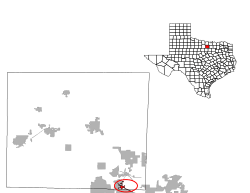Newark, Texas facts for kids
Quick facts for kids
Newark, Texas
|
|
|---|---|

Location of Newark, Texas
|
|
 |
|
| Country | United States |
| State | Texas |
| Counties | Wise, Tarrant |
| Established | 1951 |
| Government | |
| • Type | The City of Newark is a type "A" General Law Municipality. The City Council consists of a Mayor and five councilmembers. The Council appoints a City Attorney, an Internal Auditor and a Municipal Judge. Council members also appoint citizens to serve on various Boards and Commissions. |
| Area | |
| • Total | 0.90 sq mi (2.32 km2) |
| • Land | 0.90 sq mi (2.32 km2) |
| • Water | 0.00 sq mi (0.00 km2) |
| Elevation | 686 ft (209 m) |
| Population
(2020)
|
|
| • Total | 1,096 |
| • Density | 1,218/sq mi (472.4/km2) |
| Time zone | UTC-6 (Central (CST)) |
| • Summer (DST) | UTC-5 (CDT) |
| ZIP code |
76071
|
| Area code(s) | 817 |
| FIPS code | 48-50772 |
| GNIS feature ID | 2411239 |
Newark is a small city located in Texas, USA. It is split between two counties: Tarrant County and Wise County. In 2020, about 1,096 people lived in Newark.
Contents
History of Newark, Texas
People started settling in the area where Newark is now back in the mid-1850s. At first, the community was called Caddo Village. This name came from the many items left behind by the Caddo Native American people. These items were found along the West Fork of the Trinity River.
In 1893, the Rock Island Railroad reached the town. After the railroad arrived, officials mapped out plots of land for the town. The community was then named Newark, possibly after Newark, New Jersey. G. K. Foster, a civil engineer who helped plan the town, might have been from there.
Newark was a successful farming community for many years, especially until the 1920s. It became an important place for farmers to buy and sell goods again by the late 1940s. Finally, in 1951, Newark officially became an incorporated city.
Where is Newark Located?
Newark is located in the state of Texas. According to the United States Census Bureau, the city covers a total area of about 2.3 square kilometers (or 0.90 square miles). All of this area is land, meaning there are no large lakes or rivers within the city limits.
Who Lives in Newark? (Population and People)
The word "demographics" refers to information about the people who live in a place, like their age, race, and how many there are.
Here's how Newark's population has changed over the years:
| Historical population | |||
|---|---|---|---|
| Census | Pop. | %± | |
| 1960 | 392 | — | |
| 1970 | 407 | 3.8% | |
| 1980 | 466 | 14.5% | |
| 1990 | 651 | 39.7% | |
| 2000 | 887 | 36.3% | |
| 2010 | 1,005 | 13.3% | |
| 2020 | 1,096 | 9.1% | |
| 2023 (est.) | 1,233 | 22.7% | |
| U.S. Decennial Census | |||
The table below shows the different groups of people living in Newark as of the 2020 census. "NH" means "Non-Hispanic."
| Race | Number | Percentage |
|---|---|---|
| White (NH) | 697 | 63.59% |
| Black or African American (NH) | 18 | 1.64% |
| Native American or Alaska Native (NH) | 10 | 0.91% |
| Asian (NH) | 4 | 0.36% |
| Some Other Race (NH) | 4 | 0.36% |
| Mixed/Multi-Racial (NH) | 35 | 3.19% |
| Hispanic or Latino | 328 | 29.93% |
| Total | 1,096 |
In 2020, there were 1,096 people living in Newark. These people made up 351 households, and 280 of those households were families.
See also
 In Spanish: Newark (Texas) para niños
In Spanish: Newark (Texas) para niños

